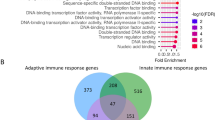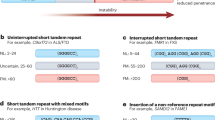Abstract
Tandemly repeated DNA sequences are highly dynamic components of genomes1. Most repeats are in intergenic regions, but some are in coding sequences or pseudogenes2. In humans, expansion of intragenic triplet repeats is associated with various diseases, including Huntington chorea and fragile X syndrome3,4. The persistence of intragenic repeats in genomes suggests that there is a compensating benefit. Here we show that in the genome of Saccharomyces cerevisiae, most genes containing intragenic repeats encode cell-wall proteins. The repeats trigger frequent recombination events in the gene or between the gene and a pseudogene, causing expansion and contraction in the gene size. This size variation creates quantitative alterations in phenotypes (e.g., adhesion, flocculation or biofilm formation). We propose that variation in intragenic repeat number provides the functional diversity of cell surface antigens that, in fungi and other pathogens, allows rapid adaptation to the environment and elusion of the host immune system.
This is a preview of subscription content, access via your institution
Access options
Subscribe to this journal
Receive 12 print issues and online access
$209.00 per year
only $17.42 per issue
Buy this article
- Purchase on SpringerLink
- Instant access to full article PDF
Prices may be subject to local taxes which are calculated during checkout





Similar content being viewed by others
References
Hartl, D.L. Molecular melodies in high and low C. Nat. Rev. Genet. 1, 145–149 (2000).
Verstrepen, K.J., Reynolds, T.B. & Fink, G.R. Origins of variation in the fungal cell surface. Nat. Rev. Microbiol. 2, 533–540 (2004).
Li, Y.C., Korol, A.B., Fahima, T. & Nevo, E. Microsatellites within genes: structure, function and evolution. Mol. Biol. Evol. 21, 991–1007 (2004).
Jin, P., Alisch, R.S. & Warren, S.T. RNA and microRNAs in fragile X mental retardation. Nat. Cell Biol. 6, 1048–1053 (2004).
Kellis, M., Patterson, N., Endrizzi, M., Birren, B. & Lander, E.S. Sequencing and comparison of yeast species to identify genes and regulatory elements. Nature 423, 241–254 (2003).
Guo, B., Styles, C.A., Feng, Q. & Fink, G. A Saccharomyces gene family involved in invasive growth, cell-cell adhesion, and mating. Proc. Natl. Acad. Sci. USA 97, 12158–12163 (2000).
Harrison, P. et al. A small reservoir of disabled ORFs in the yeast genome and its implications for the dynamics of proteome evolution. J. Mol. Biol. 316, 409–419 (2002).
Liu, H.P., Styles, C.A. & Fink, G.R. Saccharomyces cerevisiae S288C has a mutation in FLO8, a gene required for filamentous growth. Genetics 144, 967–978 (1996).
Lovett, S.T. Encoded errors: mutations and rearrangements mediated by misalignment at repetitive DNA sequences. Mol. Microbiol. 52, 1243–1253 (2004).
Viguera, E., Canceill, D. & Ehrlich, S.D. Replication slippage involves DNA polymerase pausing and dissociation. EMBO J. 20, 2587–2595 (2001).
Paques, F. & Haber, J.E. Multiple pathways of recombination induced by double-strand breaks in Saccharomyces cerevisiae. Microbiol. Mol. Biol. Rev. 63, 349–404 (1999).
Richard, G.F., Dujon, B. & Haber, J.E. Double-strand break repair can lead to high frequencies of deletions within short CAG CTG trinucleotide repeats. Mol. Gen. Genet. 261, 871–882 (1999).
Kokoska, R.J. et al. Destabilization of yeast micro- and minisatellite DNA sequences by mutations affecting a nuclease involved in Okazaki fragment processing (rad27) and DNA polymerase delta (pol3-t). Mol. Cell. Biol. 18, 2779–2788 (1998).
Callahan, J.L., Andrews, K.J., Zakian, V.A. & Freudenreich, C.H. Mutations in yeast replication proteins that increase CAG/CTG expansions also increase repeat fragility. Mol. Cell. Biol. 23, 7849–7860 (2003).
Debrauwère, H., Loeillet, S., Lin, W. & Nicolas, A. Links between replication and recombination in Saccharomyces cerevisiae: a hypersensitive requirement for homologous recombination in the absence of Rad27 activity. Proc. Natl. Acad. Sci. USA 98, 8263–8269 (2001).
Krogh, B.O. & Symington, L.S. Recombination proteins in yeast. Annu. Rev. Genet. 38, 233–271 (2004).
Davis, A.P. & Symington, L.S. The yeast recombinational repair protein Rad59 interacts with Rad52 and stimulates single-strand annealing. Genetics 159, 515–525 (2001).
Hood, D.W. et al. DNA repeats identify novel virulence genes in Haemophilus influenzae. Proc. Natl. Acad. Sci. USA 93, 11121–11125 (1996).
Keim, P. et al. Molecular diversity in Bacillus anthracis. J. Appl. Microbiol. 87, 215–217 (1999).
Boceta, C., Alonso, C. & Jimenez-Ruiz, A. Leucine rich repeats are the main epitopes in Leishmania infantum PSA during canine and human visceral leishmaniasis. Parasite Immunol. 22, 55–62 (2000).
Sakihama, N. et al. Relative frequencies of polymorphisms of variation in Block 2 repeats and 5′ recombinant types of Plasmodium falciparum msp1 alleles. Parasitol. Int. 53, 59–67 (2004).
Pays, E., Vanhamme, L. & Berberof, M. Genetic controls for the expression of surface antigens in African trypanosomes. Annu. Rev. Microbiol. 48, 25–52 (1994).
Fondon, J.W. III & Garner, H.R. Molecular origins of rapid and continuous morphological evolution. Proc. Natl. Acad. Sci. USA 101, 18058–18063 (2004).
Schroeder, J.A. et al. MUC1 overexpression results in mammary gland tumorigenesis and prolonged alveolar differentiation. Oncogene 23, 5739–5747 (2004).
Patton, S., Gendler, S.J. & Spicer, A.P. The epithelial mucin, MUC1, of milk, mammary gland and other tissues. Biochim. Biophys. Acta 1241, 407–423 (1995).
Rice, P., Longden, I. & Bleasby, A. EMBOSS: the European molecular biology open software suite. Trends Genet. 16, 276–277 (2000).
Sherman, F., Fink, G.R. & Hicks, J. Methods in Yeast Genetics (Cold Spring Harbor Laboratory Press, Cold Spring Harbor, New York, 1991).
Sikorski, R.S. & Hieter, P. A system of shuttle vectors and yeast host strains designed for efficient manipulation of DNA in Saccharomyces cerevisiae. Genetics 122, 19–27 (1989).
Reynolds, T.B. & Fink, G.R. Bakers' yeast, a model for fungal biofilm formation. Science 291, 878–881 (2001).
Marinangeli, P., Angelozii, D., Ciani, M., Clementi, F. & Mannazzu, M. Minisatellites in Saccharomyces cerevisiae genes encoding cel wall proteins: a new way towards wine strain characterisation. FEMS Yeast Res. 4, 427–435 (2004).
Acknowledgements
We thank A. Sinskey, A. Amon, T. Petes and all members of the laboratory of G.R.F. for discussions; K. Walker for assistance with the bioinformatics; and T. DiCesare for help with the graphics. K.J.V. is a post-doctoral fellow of the Fund for Scientific Research Flanders (F.W.O. Vlaanderen) and a D. Collen Fellow of the Belgian American Educational Foundation (B.A.E.F.). G.R.F. is an American Cancer Society Professor of Genetics. This research was supported by a grant from the US National Institutes of Health to G.R.F.
Author information
Authors and Affiliations
Corresponding author
Ethics declarations
Competing interests
The authors declare no competing financial interests.
Supplementary information
Supplementary Fig. 1
Size comparison of the repetitive domains of the 29 S. cerevisiae ORFs containing long (≥ 40 nt) intragenic repeats in six different yeast strains. (PDF 1148 kb)
Supplementary Fig. 2
Size comparison of the repetitive domains of the 15 S. cerevisiae ORFs containing short (< 40 nt) intragenic repeats in six different yeast strains. (PDF 1069 kb)
Supplementary Fig. 3
Size comparison of 16 ORFs without intragenic repeats in six yeast strains. (PDF 1127 kb)
Supplementary Fig. 4
Alignment of the FLO1 repetitive region of the wild-type S. cerevisiae S288C strain and that of shorter FLO1 alleles. (PDF 1413 kb)
Supplementary Fig. 5
Model of recombination of intragenic repeats. (PDF 1087 kb)
Supplementary Table 1
ETANDEM analysis of all S. cerevisiae ORFs that contain intragenic repeats. (PDF 191 kb)
Supplementary Table 2
Yeast strains. (PDF 31 kb)
Supplementary Table 3
PCR primer sequences. (PDF 39 kb)
Rights and permissions
About this article
Cite this article
Verstrepen, K., Jansen, A., Lewitter, F. et al. Intragenic tandem repeats generate functional variability. Nat Genet 37, 986–990 (2005). https://doi.org/10.1038/ng1618
Received:
Accepted:
Published:
Issue Date:
DOI: https://doi.org/10.1038/ng1618



